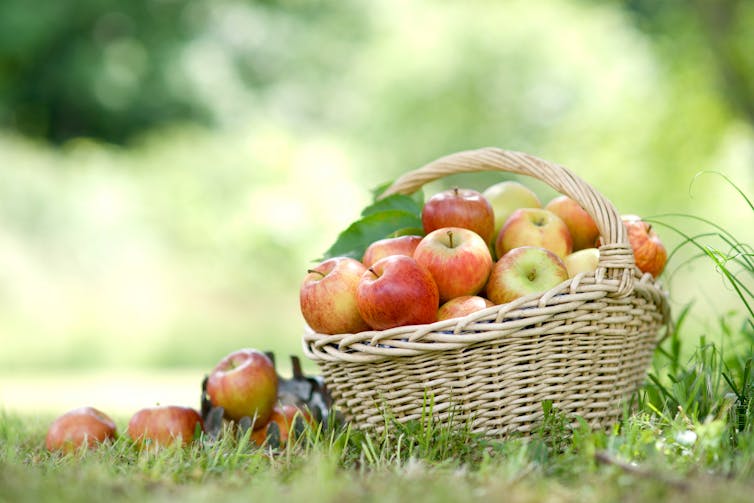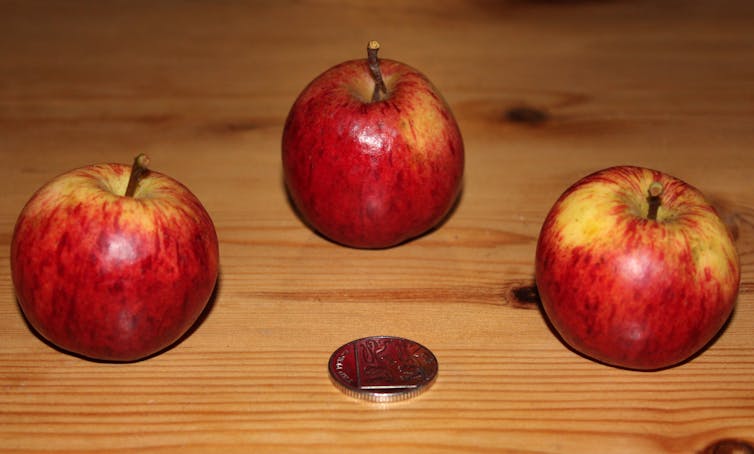Sut mae gwyddor fforensig wedi cynorthwyo i ailddarganfod afalau anghofiedig
19 Hydref 2018

Danny Thorogood, Aberystwyth University
It’s been a good year for apples. Across Europe the apple harvest is the biggest it has been for a decade. But the handful of apple types you see on supermarket shelves only tells part of the story. There are actually 7,500 varieties of eating apple grown all over the world, and growers and scientists are making efforts to conserve and extend this.
Many people will have heard the story of Granny Smith apples, every one of which can reportedly be traced back to a single seedling plant found growing in Australia in 1868. Though not all plants have found the fame that this crisp green apple has, there are numerous varieties that are – like the Granny Smith once was –, peculiar to a local region and rarely, if ever, grown elsewhere.
The UK has more than 3,600 registered apple varieties recorded in the National Fruit Collection (NFC). Though it was once thought that 200 types were being grown in Wales, only about 50 (with investigations ongoing) are known to exist today. That this number is not lower is thanks to the pioneering endeavours of the likes of nurseryman Ian Sturrock, who began propogating the now world-famous Afal Enlli – along with other rare Welsh heritage apple trees – after its rediscovery in 1998. All Afal Enlli trees now sold come from one tree that may have been cultivated by generations of monks who lived on Bardsey Island at the tip of the Llyn Peninsula around 1,000 years ago.
Sometimes it is easy for experts to identify a type of apple as being an existing variety, or even a new variety never seen before, when they have a very distinct look. But that can’t always be done. So modern researchers have been turning to DNA profiling technology, similar to that used by forensic scientists.
It’s all in the DNA
DNA profiling has become an essential tool for characterising the genetic diversity of apples and shaping collection strategies. The technique works by identifying small sections of DNA called simple sequence repeats (SSRs). These stretches of DNA do not code for genes, but the number of repeats within them varies between individuals. By analysing a number of SSRs, a unique “fingerprint” for each individual can be built up.
These fingerprints are then compared to the profiles in the NFC database and either matched to an existing variety or, when there is no match, we can be sure it has never been characterised before and is possibly a newly discovered or rediscovered variety.

This is precisely what the Welsh Perry and Cider Society’s Jayne Hunt has been doing, as part of the first concerted effort to identify and conserve old unknown varieties of apple and pear trees growing in Wales. Hunt’s team extracted DNA from hundreds of apple leaves collected from derelict orchards throughout Wales, created a genetic profile for each tree, and compared them with the NFC database.
Though the work did identify previously declared Welsh Heritage varieties as having pre-existing duplicates in the NFC database (enabling current collections to be rationalised), the results have overall been fascinating and many unique trees have been found.
Of course, there is a proviso. Just because a variety is declared unique, it doesn’t make it useful and worth conserving. The nature of breeding means that every seedling grown from a pip will be unique, combining characteristics from the mother tree and its pollinator. Often the seedlings are but poor reflections of the parent trees. This is why another part of Hunt’s project is really important: histories and anecdotes from farmers, growers and members of the public have been documented, to share their intimate knowledge of the trees and their uses. With these verbal historical records and further investigation of the variety’s properties it is possible to determine if the newly discovered or rediscovered apple variety is a real gem worth conserving.
At Aberystwyth University, we are currently planning extension projects to take this work further. We have been sampling trees from derelict orchards on university land that are at least 60 years old. Our own DNA profiling has found that, by and large, the trees are existing varieties popular at the time of planting and were most likely obtained from the catalogues of English nurseries – varieties such as Bramley’s Seedling, Cox’s Orange Pippin and Blenheim Orange and then the slightly more unusual Allington Pippin and Lady Sudeley. These were likely to have been planted simply because they were popular at the time and not necessarily because they were suited to the local weather conditions.
But two trees have been found to be unique and we are currently evaluating their properties. Whether their existence lies in their specific adaptation to the local climate and aspect, or is more due to random chance, we don’t really know – but they certainly extend the genetic diversity of our global resource. Never has it been more important to preserve our crop genetic diversity, not only for our increased pleasure but, more pressingly, to provide a reliable and economically sustainable source of food in the face of climate change.
And maybe one of the newly identified Welsh varieties will become a global success like the Granny Smith.![]()
Danny Thorogood, Principal Investigator, Aberystwyth University
This article is republished from The Conversation under a Creative Commons license. Read the original article.



